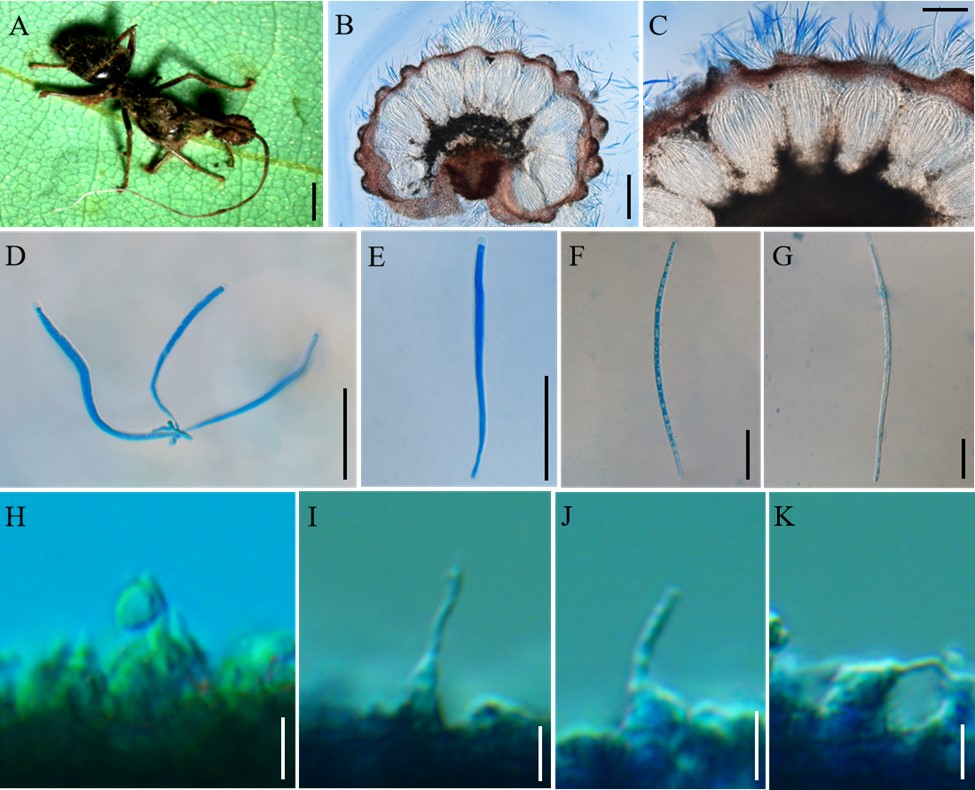Ophiocordyceps basiascus H. Yu & D.X. Tang.
MycoBank number: MB; Index Fungorum number: IF; Facesoffungi number: FoF 11706;
Description
Subtropical monsoon evergreen. Camponotus sp. infected and biting the main vein of a leaf. It was collected from 1.5 m above the ground. Sexual state: External mycelium was produced from the sutures and joints, only one stroma was produced from the head of the ant, curved at the top, cylindrical, clavate, and the bottom of the stroma was dark brown, pale white at the top. The ascoma of lateral cushions produced from basal of the stroma, only one ascoma was observed, spherical, brown, averaging 3 × 2 mm. Perithecia flask-shaped or ovoid, immersed to partially erumpent, with short, exposed neck or rounded ostiole, 195–248 × 92–149 μm. Asci cylindrical, hyaline, eight-spored, 96–212 × 4–10 μm. Ascus caps were hemispherical, 3–5 µm high, 4–5 µm wide. Ascospore vermiform, hyaline, septate, round to slightly tapered at apex, 89–122 × 2–3 µm. Asexual state: Hirsutella type-A present on the stroma. Phialides lageniform, smooth, swollen base, tapering abruptly a neck, short, 8–26 × 1–5 µm. Conidia oviform, hyaline, smooth-walled, 1–4 × 1–2 µm.
Material examined: CHINA, biting on leaves of tree seedlings, 19 August 2020, H. Yu (YHH 20190, neotype).
Distribution: Puer City, Yunnan Province, China
Sequence data: LSU: ON555910 (LROR/LR5); SSU: ON555828 (NS1/NS4); EF1a: ON567748 (983F/2218R); RPB1: ON568672 (RPB1/RPB1Cr_oph); RPB2: ON568121 (fRPB2-5F/fRPB2-7cR)
Notes: Phylogenetic analyses showed that O. basiascus formed a separate clade in the O. unilateralis core clade, it was close to O. subtiliphialides and O. contiispora, with statistical support from BI posterior probabilities (PP = 100%) and ML bootstrap proportions (BP = 97%). O. basiascus was similar to O. subtiliphialides and O. contiispora in the behavior of the host biting a leaf. The perithecia with flask-shaped, immersed to a few partially erumpent, with short, exposed ostiole and asci cylindrical were similar to O. contiispora. It was also similar to O. subtiliphialides and O. contiispora in producing phialides with lageniform, conidia olivary. However, O. basiascus was different from O. subtiliphialides and O. contiispora by ascospore vermiform, only Hirsutella type-A present on the stroma, the size of perithecia, asci, ascospore, phialides and conidia also differed from O. subtiliphialides and O. contiispora.

Fig. 5. Ophiocordyceps basiascus (YHH 20190). A: Camponotus sp. infected and biting the main vein of a leaf. B-C: Cross-section of the ascoma showing the perithecial arrangement. D–E: Asci. F-G: Ascospores. H: Conidiogenous cells and conidia. I-K: Phialides. Scale bars: A = 2000 µm; B = 200 µm; C = 100 µm; D-E = 50 µm; F-G = 20 µm; H-K = 5 µm.
